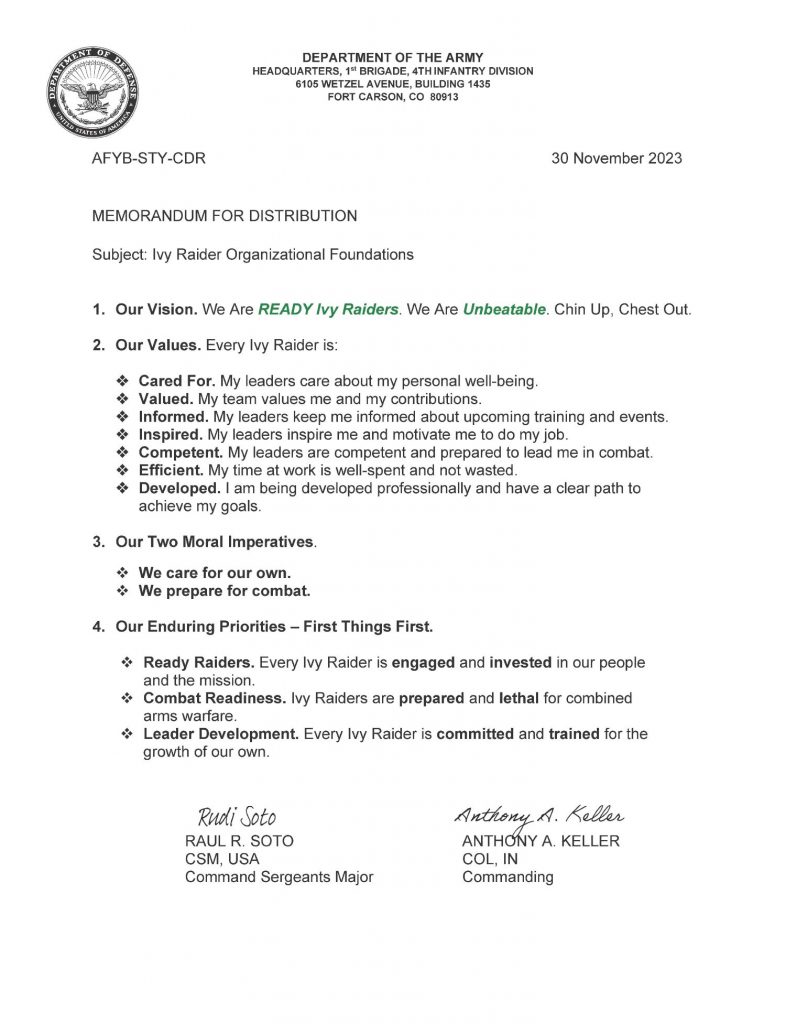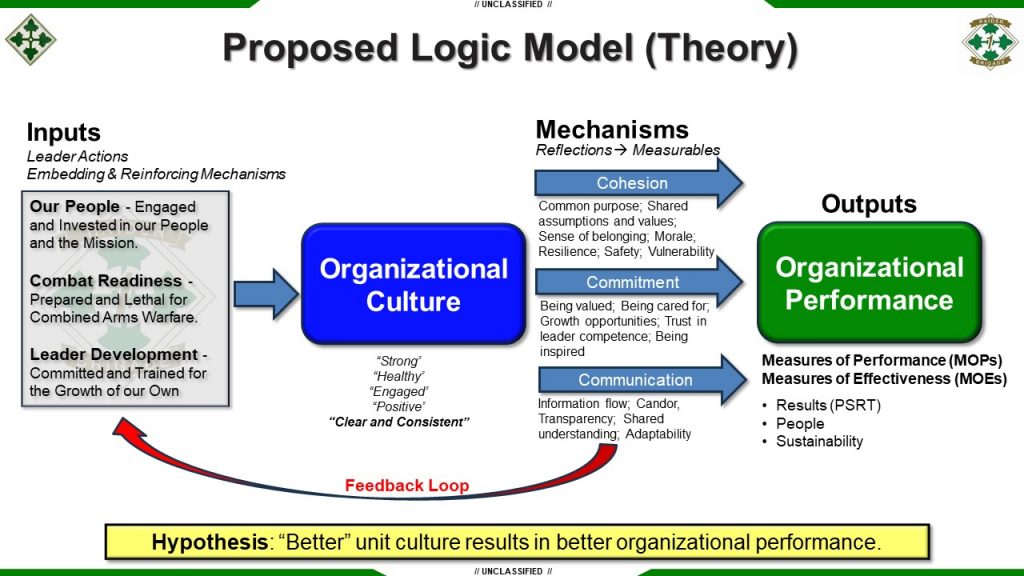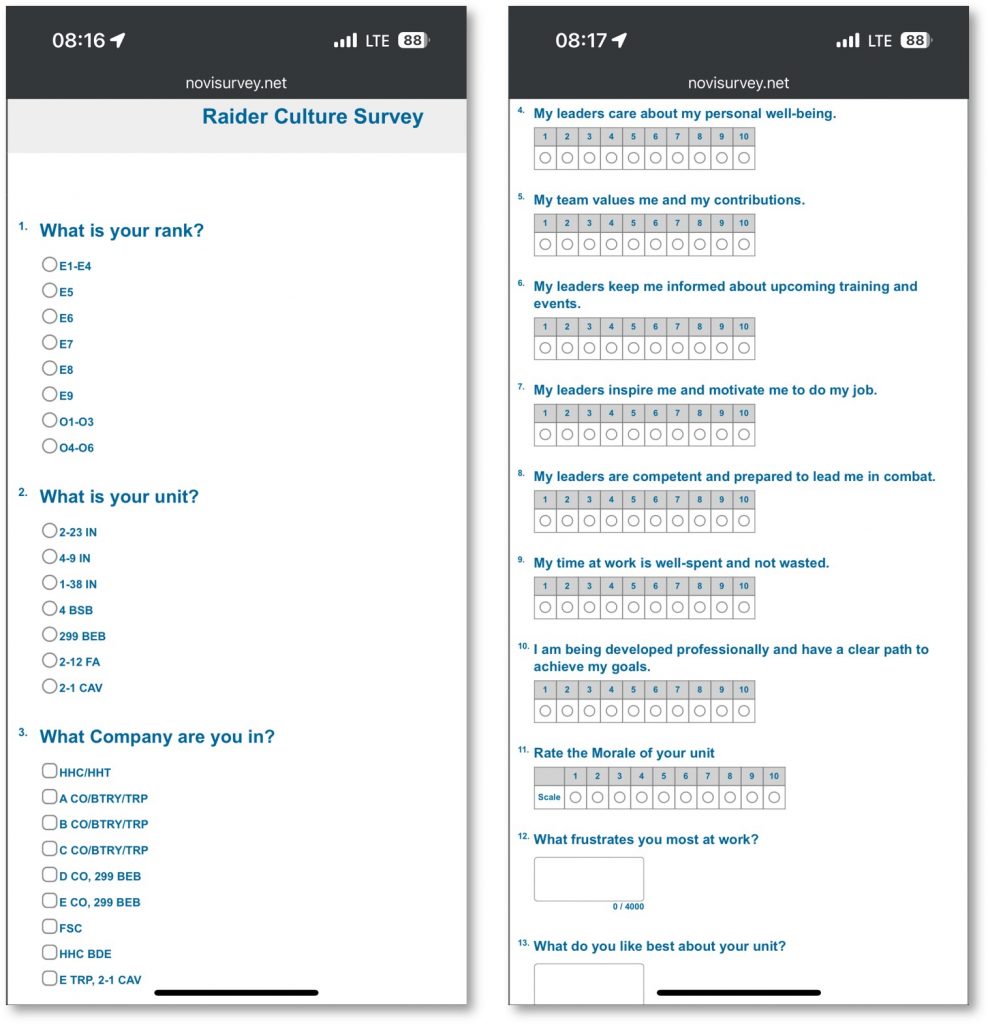“Culture eats strategy for breakfast.” This famous quote, most typically (and perhaps apocryphally) attributed to the late management author Peter Drucker, highlights the impact that organizational culture can have, for better or worse. Few other things in an organization so effectively shape its results and cohesion. A body of research demonstrates the robust link between organizational culture and performance.
For military organizations, where the difference between success and failure can be measured in lives, understanding that link is especially crucial. Yet, cultivating the type of culture that enables a unit to consistently achieve its assigned mission is far from easy. Leaders can say culture matters and that they want to build strong unit identities, but without dedicating time, attention, and resources, such statements are little more than aspirations. Or worse, without deliberate effort, unit culture can drift in a direction not aligned with the commander’s intent.
How do leaders invest in unit culture in a way that increases performance? The 1st Stryker Brigade Combat Team (“Raider Brigade”), 4th Infantry Division at Fort Carson, Colorado recently experimented with a three-step culture framework (art, science, and action). Our hypothesis is that integrating the art and science of culture allows us to drive decisions and action using data-centric feedback loops that increase readiness and strengthen the organization over the long term, ultimately increasing organizational alignment and commitment. While still in the early phases of our assessments, initial results suggest that the investment in unit culture has proven worthwhile.
Step 1: The Art—Clearly Defining Unit Culture
What is culture and what do we want ours to be? This was the overarching question for the Raider Brigade’s two-day off-site culture conference, which brought together 150 of the unit’s leaders (ranging from company/troop/battery to brigade command teams, along with noncommissioned officers and junior soldiers) to achieve consensus on what culture is based on existing research and doctrine. Through discussion and group exercises, we developed a common definition:
Culture is a community’s set of enduring values, beliefs, norms, and underlying assumptions expressed through symbols, traditions, and practices that are expected by all members, which leads to increased cohesion and performance.
Next, we applied this common definition to capture our desired unit culture at echelon from brigade to company/troop/battery level. The discussions focused first on defining the current reality, and then on describing a vision of the unit’s culture the leaders aspired to develop. During the off-site, the brigade’s leaders explored existing doctrine and research on culture, learned a common framework for culture using Edgar Schein’s three-level model with recommendations on how to operationalize the model, and learned the science of measuring culture through data collection and assessment. Leaders also engaged in small group activities to study historical cases (NASA and Alcoa) to practice assessing culture, define the division and brigade cultures, and begin designing subordinate formation cultures that are nested within the brigade’s.
The event accomplished four key outcomes. First, it defined the culture we aspire to create through culture statements identifying who we are, what we do, and why we do it. Second, it informed leaders and empowered them to thoughtfully cultivate culture moving forward. It also proposed an innovative method for measuring culture both quantitatively and qualitatively using a periodic cell phone–based survey. Lastly, the event generated buy-in for the resulting Raider Brigade’s organizational foundations document, pictured below, which clearly defines who we aim to be.
Step 2: The Science—Systematically Measuring Unit Culture
With an initial framework in place, we next needed to determine a way to assess whether we were living up to our cultural expectations over time. Measuring culture directly is difficult—no common scale (such as 0–10, strong vs. weak, etc.) exists—but we attempted to indirectly measure it through soldier assessments of our culture measurables (or values, as defined in the memorandum above). To do this, we drafted a logic model (shown below) that proposes a theory for how leader inputs shape culture and then the mechanisms by which culture affects unit performance.
Relying on academic literature and leader experience, we proposed three mechanisms by which culture affects daily operations: cohesion, commitment, and communication. Since these concepts are difficult to measure directly, we identified distinct elements within each mechanism, such as information flow and trust in leader competence, which we could measure by surveying soldiers. These became our seven culture measurables, which serve as visible metrics for how culture affects day-to-day operations across the organization. These measurables are communicated as our organizational values as they aim to govern leader behavior, just as the Army values govern all soldiers’ behavior. To ensure that our culture metrics are nested, we mapped them to the brigade commander’s priorities, also published in the organizational foundations document.
We operationalized these measurables by building a survey using Army-approved Novi Survey software and crafted the seven measurables into questions about soldier assessments of various aspects of their unit culture, using a 0–10 Likert scale. The short survey, easily administered over cell phone, also includes questions about respondent demographics (rank, battalion, company), assessment of unit morale, and two free-text questions (what soldiers like best about the unit and what frustrates them most), shown below.
Members of the Raider Brigade take the survey periodically (every one to three months) during division readiness days or payday activities. It takes as little as thirty seconds and can be taken while in a closeout formation after soldiers scan a QR code with their phones. Equipped with the survey data, leaders can both capture current snapshots and track trends by unit and rank, helping inform their decisions with objective data rather than subjective perceptions or isolated anecdotes.
The brigade staff takes survey results across the brigade and publishes individualized reports for each battalion/squadron, to allow command teams to visualize descriptive statistics (with boxplots to display dispersion of responses) using Microsoft’s Power BI software for each question down to the company/troop/battery level. The free-text comments provide valuable, anonymous context for the quantitative results. Units then follow up the quantitative survey with a qualitative survey by unit ministry teams. After viewing the quantitative survey results, chaplains develop follow-on surveys given face-to-face to validate the quantitative results and provide further context to drive appropriate action.
As an example of how surveys directly feed into culture development, during the pilot iterations of the survey, one battalion received relatively low scores for information flow and soldier inspiration. From this, the command team was able to prioritize those two areas through better communication and unit heritage events. The subsequent survey results suggested that the efforts were successful, as average scores in both areas increased by nearly 20 percent. Applying data analytics to this emerging culture dataset is promising, as we used linear regression to discover a link between a company’s “Development” score and its current retention results. It is likely that a larger dataset will provide insights into connections between unit culture and lethality or harmful behaviors.
Periodic culture surveys provide leaders a data-informed feedback loop with which to assess culture and make evidence-based decisions as to where to invest their time and resources. Completing the surveys and periodically reviewing their data keeps leaders engaged in what the brigade is striving to accomplish—and aligned with the commander’s priorities. It encourages continuous attention on and conversations about the unit culture. And the surveys enable the brigade’s organizational foundations framework and the impacts of the initial culture conference to remain salient throughout the formations.
Step 3: The Action—Continue to Cultivate Unit Culture
Organizational culture is intrinsically linked to change. When members’ enacted behaviors do not align with what the unit espouses, that signals a need for change. Critical to organizational change in John Kotter’s eight-step model is building a guiding coalition. Units can drive cultural change from the top down through the formal chain of command. However, this can be supplemented with a more robust approach by involving informal leaders in the process. This invites leaders, both formal and informal, at many echelons to use their spheres of influence to achieve a more complete change effort. Involving young soldiers, junior noncommissioned officers, and junior officers to help build a unit’s culture encourages them to take ownership of that culture and what the unit is striving to achieve.
A way the Raider Brigade continues to invest in its culture development and build guiding coalitions at all levels is through subordinate battalion culture events. One approach by a battalion leverages monthly culture days, which bring a small group of soldiers, noncommissioned officers, and officers within the battalion (approximately thirty total people per session) together for a day to conduct their own off-site culture conference experience.
The day is built around the framework of celebrating the battalion’s past, crafting its present, and improving its future. The battalion’s culture day starts with a history-based physical training event where small groups move between stations, which are situated at meaningful locations across the installation that reflect important events in the unit’s history. At each station, members learn about a key event from the battalion’s history and then conduct physical exercises to celebrate it. The battalion’s past is further brought to life through soldier stories and citations of valor. Leaders then describe the battalion’s crest and the meaning of its design.
The battalion culture day transitions to the unit’s present with leaders providing the models that the brigade uses to define culture (Schein’s three-level model and the brigade’s organizational foundations). Soldiers then have the opportunity to use this knowledge and help craft the battalion’s existing cultural framework and ways to improve it through the addition, refinement, or removal of the unit’s cultural artifacts. Finally, the group looks to the battalion’s future by identifying some of its biggest problems or challenges, and then collaborating to develop solutions to address them. From these battalion-level culture days, participating leaders at numerous echelons within the unit return to their formations more informed about unit culture, better equipped to steward it, and inspired to accept ownership to help shape it. They become part of the coalition to help champion the change necessary to continue unit culture development.
Leaders are not victims of culture. We shape culture. We drive it. This was the clear call to action for leaders at the end of the first Raider Brigade culture conference. With their new shared knowledge on the science of culture, the unit’s approach to measuring it, and clarity on the culture that the brigade aspires to achieve, leaders departed the conference with a culminating question: Now what?
This unit campaign toward intentional culture development was designed to achieve what the brigade captured as the purpose in its definition of culture: to increase cohesion and performance. Cohesion and performance lead to a more ready formation. In the first quarter of this approach to developing culture, the brigade has developed a data-informed feedback loop with which to continually assess and strengthen it. As a result, soldiers better understand their units. They are clearer about who they are, what they do, and why they do it. Leaders share a common framework and language to remain on consistent messages that nest within those of higher echelons. Leaders can also more accurately monitor the pulse of their units through regular data collection.
While the Raider Brigade’s methodology toward culture development is still in its early phases, we have seen gains from leveraging an integration of the art and science of culture to drive action. Our survey results indicate that our people are more invested, our identity is clear, and our leaders are more responsive. We also have a better sense of the size and scope of our problems, which is helping us address them head-on. We will continue to assess costs and benefits of using culture as a line of effort to build a formation ready to accomplish its combat mission while developing the next generation of leaders. However, these early signals communicate that our brigade’s cultural development efforts are creating a more lethal, cohesive, and committed organization capable of responding to our nation’s call.
Major Josh Bowen is a US Army engineer officer currently serving as the operations officer for 299 BEB, 1/4 SBCT at Fort Carson, Colorado. With an MA in social and organizational psychology from Columbia University, he uses his education and previous experience as a USMA tactical officer to help cultivate intentional cultures and leader development strategies in the units he serves in.
Lieutenant Colonel Jon Bate is a US Army infantry officer currently serving as commander of 2-23 IN, 1/4 SBCT at Fort Carson, Colorado. A Goodpaster Scholar in the Advanced Strategic Planning and Policy Program (ASP3), he holds an MPP from the Harvard Kennedy School and PhD in Political Science from Stanford University.
The views expressed are those of the authors and do not reflect the official position of the United States Military Academy, Department of the Army, or Department of Defense.







